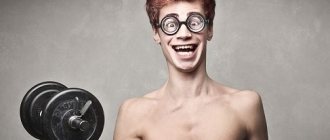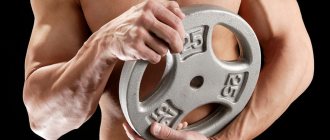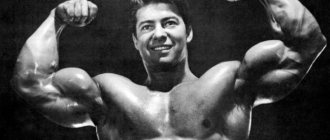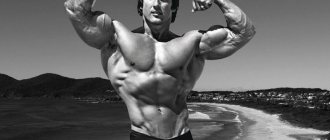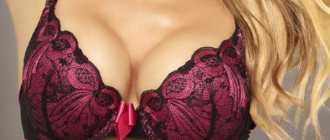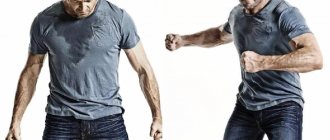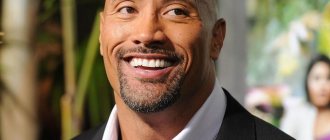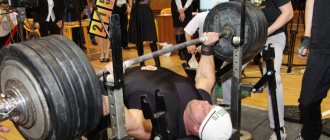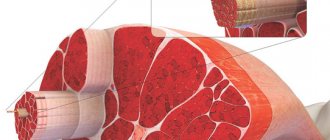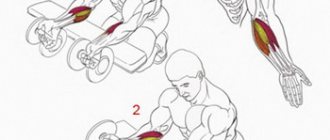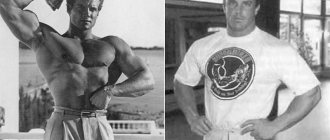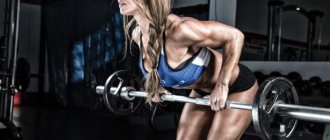Unfortunately, athletes are not always able to progress quickly. If your arms don't grow, then don't despair. Scientists claim that if a certain muscle is lagging behind in its development, the reason for this lies in the genetics of one of the bundles. In relation to the triceps, this is most often the long section, and for the biceps it is the internal section. However, working hard on their development may not be enough, since most likely the reason lies in genetics. Today, with the help of professional athletes, we will try to figure out what to do if our arms don’t grow.
Basic triceps exercises
The list of the most effective exercises includes 5 exercises:
- dips
- bench press, close grip
- French bench press
- French press sitting/standing
- arm extension on a block
This list contains both basic exercises and isolating ones (they affect only a specific muscle group).
Dips
A basic exercise that we recommend doing at the beginning of your triceps workout.
When performing, it is important to keep your body straight, without leaning forward. If you spread your elbows to the sides during the process, the load will go to the external triceps, while the elbows pressed to the body will load the long (most important) part of the muscle
Be sure to fully straighten your arms at the top point to eliminate the bend in your elbows.
Close-grip bench press
A basic exercise recommended for performing at the very beginning of training. Don't forget about the mandatory warm-up, because... there is a risk of injury - the working weight of the apparatus for this exercise is usually the largest among other triceps exercises. It is advisable to carry out the training on a bench with a negative incline, which will give a greater effect, since the load will be less on the deltoids.
When performing, the grip should be shoulder-width apart, and the elbows should be pressed as close to the body as possible. If you spread your elbows further, the load will “flow” onto the outer triceps.
French bench press
Isolated exercise with a load on the elbow joint. When performing, watch where the barbell falls. If at the lowest point it is at the level of the nose or forehead, the external triceps works, and when lowered behind the head, the long triceps works. The projectile must be taken with the palms up to load our core muscles, otherwise the outer part will work. The rules regarding the placement of the elbows are similar: the closer to the body, the better for a long bundle of muscles.
French press sitting/standing
Another isolated exercise. As an exception, the optimal grip would be palms down. We remember about the elbows - the closer, the better the muscle we are interested in is loaded. The exercise can be performed without a barbell, using 1-2 dumbbells at your own discretion. How to make a choice? According to your own feelings, whatever “goes well” with it, use it.
Extension of arms on a block
Isolation exercise. It is convenient because it allows you to choose a comfortable position for your body while standing, and the grip can be any (if appropriate handles are provided). If the handle of the block is a rope, then it is recommended to turn your palms towards the floor at the lowest point, which will have a greater impact on the long part of the muscle. The question of the location of the elbows is similar to all previous exercises - the closer to the body, the better.
Let's sum it up
We hope that now you have an understanding of the importance of the triceps in arm size. You know its structure and the most effective exercises
All that remains is to act and remember that regular training is the engine of progress!
Peter Putnam's Arm Training Tips
Peter's arms grow quite slowly, lagging even behind his legs in the speed of progress. The athlete is sure that when a muscle is behind in its development, it is impossible to feel it during training. By using light weights, the connection between the brain and muscles must first be strengthened. If your arms are not growing when using a standard split system, then start working on your biceps and triceps in one session.
Biceps training according to Putnam
For biceps training, Putnam developed his own methodology. Its essence lies in alternating two types of training during one lesson. The first workout consists of three movements to grow all sections of the biceps. The second workout is experimental and here it is necessary to use other exercises and experiment with angles of application of the load and working weight.
Peter considers standing barbell lifts to be the best movement for training biceps. The next step in the athlete's program is a lift on the Scott bench. These are the exercises for the first workout. Putnam then begins to experiment and constantly changes the exercises and the order in which they are performed.
Triceps training according to Putnam
The first exercise when working on the triceps is the French press, which maximally works the long section. Then comes the turn of EZ-bar extensions from behind the head, and the session ends with downward presses. It is important to note that in the last exercise it is necessary to achieve a powerful pumping effect. To do this, Peter performs fifteen repetitions using a narrow, wide, and then reverse grip.
Why don't my biceps grow?
One of the most common reasons for stunted biceps growth is overtraining of this muscle group.
Stay in the range of 3-4 sets of 8-10 reps. Focus on the weight, not the number of repetitions. There is no point in killing your arms with numerous repetitions; this does not allow you to achieve that very shock state that stimulates muscle hypertrophy. Your task is to increase the weight of the weight each workout. Focusing on isolated exercises also negatively affects muscle growth. Many athletes do not train their arms at all, but perform basic exercises every upper body workout: push-ups, pull-ups, dips. These exercises contribute to the overall increase in muscle mass, the biceps begins to grow naturally following the rest of the body.
As noted above, muscles quickly get used to the same movements, and their growth stops. If your program for a long time contains only biceps curls at one angle with a slight increase in weight, then it is not at all surprising that your biceps are not growing. Remember, exercises should be performed slowly, completely excluding work by inertia. Change the load angle regularly: to load the outer head of the biceps, use a very narrow grip; to work the inner head, on the contrary, you need a wide grip, with your elbows pressed to the sides. Be sure to target your brachialis and brachioradialis muscles with exercises like dumbbell hammer curls.
Very often, biceps do not grow due to errors in the exercise technique. Many people simply don't understand how to truly fatigue a muscle and make it work. In the gym, you can often see how exercisers, when performing isolated movements, simply swing or throw the weight, using inertia rather than muscle strength. Thus, they include all muscles in the work except those that they want to work. Lift the weight slowly and evenly, keep your biceps contracted throughout the exercise, and do not relax it at the top or bottom of the exercise. You should not allow oxygen to enter the muscles, this stimulates the release of anabolic hormones that cause muscle hypertrophy.
Exercises for the brachialis muscle
Many athletes ignore or are unaware of the brachialis muscle. And its development is needed for a more massive and impressive appearance of biceps and triceps. The biceps muscle takes up less space than the triceps and brachialis. Together with the biceps, the brachialis crosses the elbow joint and is involved in adducting the forearm to the shoulder, bending the arm at the elbow. It is located deep in the shoulder muscles, attached to the shoulder bone at one end and connected to the forearm on the other side. It does not participate in supination, but flexes the elbow joint.
When the arm is flexed (thumb pointing upward), the load is placed more on the brachialis rather than the biceps. If there is an imbalance between the development of the biceps and brachialis, then pain in the elbow joint may occur, limiting movement when pumping up the biceps.
In exercises for the brachialis, you can use hammer, reverse and spider grips, as well as overhead curls using the anatomical features of the position of the biceps: the closer they are to the head, the greater the load on the brachialis.
Exercises:
- lifting the barbell onto the biceps using a reverse grip;
- lifting dumbbells using a hammer grip;
- on the Scott bench, barbell curls;
- spider curls - bending the arms with the elbows resting.
Exercise program for phase No. 1
Exercises:
- No. 1. Cross your arms in a hammer style with dumbbells. First, warm-up exercises are performed for 10 repetitions - 2-3 approaches, then working exercises - 10 repetitions and 3 approaches.
Remember! Each muscle contraction requires a strong squeeze of the dumbbells. When lowering the dumbbells, you should fully extend your arms to warm up your lower biceps.
- No. 2. Bend your arms on a Scott bench using a barbell with a curved bar - 8 reps and 3 sets. The bar is lowered without fully straightening the arms (by 90%) to prevent injury.
- No. 3. Bend your arms in a standing position, using a straight barbell or with a curved bar, pause - 3 seconds, repetitions - 8, approaches - 2. The weight is lowered after the pause, and you can feel the muscles “burning”.
- No. 4. Extend the arms to the triceps using the torso (vertical block). Elbows pressed to the body, muscles tense at the lowest point for 1 second, repetitions - 12, approaches - 4.
- No. 5. Push-ups in a machine or on parallel bars with increasing weight in each approach. Repeat 8-12 times, 3 approaches.
- No. 6. Use a curved bar for extensions on an incline bench, repetitions - 15, approaches - 3. The weight should be lowered lower behind the head. It is not recommended to use heavy weights.
Exercise program for phase No. 2
Exercises are performed with a 45-second break:
- No. 1. The arms are bent with a reverse grip, using a straight or curved bar. Reps - 10, sets - 5, break between sets - 10 seconds.
- No. 2. The arms are extended to the triceps using a cable. Repetitions - 10, sets - 5. Warm-up exercises are performed first. The break between approaches is 10 seconds.
- No. 3. Arms are bent on a Scott bench or on a machine. Reps - 12, sets - 3. The biceps are loaded, 6 repetitions are performed independently, 6 - with the help of a partner.
- No. 4. Presses in the triceps machine. At first, do 8 heavy reps and 3 sets. There is a 3 second delay before the weight is slowly lowered. On the 4th set, the weight is set for 6 heavy negative reps.
- No. 5. Concentrately bend your arms with dumbbells using an incline bench. Reps - 8, approaches - 2.
- No. 6. Perform L-extensions for each arm. Reps - 15, sets - 4.
- No. 7. While sitting, bend your arms with dumbbells, pause - 3 seconds, repetitions - 8, approaches - 2.
- No. 8. Using a narrow grip, do the EZ-bar press, reps - 8, sets - 4. The weight is lowered slowly towards the chin, without holding it on the chest.
Conclusion. By adding variety to your workouts, you can achieve an increase in muscle mass (biceps and triceps) by 1-1.2 kg per month without the use of proteins or other drugs.
Today, most experienced bodybuilding athletes prefer to train using split programs. After several years of training, athletes can no longer fully work out all muscle groups in one or two workouts; they decide to split different muscle groups on different days of the week. Most often, 2 or 3 muscle groups are worked out in one session, since the more muscles we use during training, the greater the release of anabolic hormones will be. Today we will talk about joint training of the deltoid muscles and arms (biceps and triceps), consider the training program and effective exercises.
Reverse supinated grip pull-up
This exercise should also be included in arm training - that's what science says. For example, experts from the ACE (American Council on Exercise) organization in 2014 found that the pull-up suddenly took second place in terms of EMG activation of the biceps muscles, surpassing even the basic barbell curl and second only to the concentrated arm curl.
A couple of reasons why the pull-up is still better than any variation of the biceps curl (for mass):
- this is a multi-joint movement,
- The biceps are primarily composed of fast-twitch fibers (research) that are activated when the intensity increases (research).
So if you are aiming for maximum mass, it is recommended to start your workout with pull-ups.
2. Curls with dumbbells on an incline bench (for a long bun)
Although both biceps tendons work together when curling your arms, certain exercises can activate one or the other to a greater extent. In this movement, the emphasis is placed on the long (outer) head.
In general, all variations of biceps curls, in which the arms are moved behind the body, place more load on the long head (research).
3. Concentrated biceps curl with a dumbbell (for a short bun)
Now let's give a stimulus to the short (inner) head.
As mentioned earlier, this exercise is the champion in activating muscle fibers of all “biceps” exercises.
Maximum activation comes from a combination of arm flexion and forearm supination (outward rotation), another function of the biceps (research).
When flexing the forearm, it is important to add supination (turn outward) - this allows you to fully load the biceps muscles. Scientists also noticed that research participants gave their all with great pleasure when performing this version of the biceps curl.
Apparently, the brain-muscle connection is highest (which, of course, promotes hypertrophy)
Scientists also noticed that study participants gave their all with great pleasure when performing this version of the biceps curl. Apparently, the brain-muscle connection is highest (which, of course, promotes hypertrophy).
4. Curl with EZ bar and pronated grip (for the brachialis)
And let's finish off the arm flexors with an exercise in which the shoulder muscle (brachialis) works more.
Since the biceps are more actively involved when the forearm is supinated, a pronated grip takes the load off them and transfers them to the brachialis (study). And a curved bar is more comfortable for the joints involved (compared to a regular bar).
An example of a program for a balanced increase in biceps muscle mass:
- Pull-ups: 3 sets of 6-8 repetitions,
- Curls with dumbbells on an incline bench: 3 sets of 6-8 repetitions,
- Concentrated biceps curl with dumbbell: 3 sets of 6-10 repetitions,
- Pronated grip EZ bar curls: 3 sets of 6-12 reps.
It's unlikely that you have a separate biceps day, so it makes sense to split this program up and do it in parts on different days of the training week.
Video:
This was the basic program for balanced mass gain, and now let's work on the lagging bundles/muscles.
Fuad Abid
- How do your hands grow?
I can’t say that my hands are my strength. I started training with my arms at 32 cm.
— What mistakes did you make at the very beginning of hand training?
I didn't bother to understand the anatomy of the biceps and triceps bands, so I didn't know how the different exercises worked. As a result, I did a lot of stupid work, loaded the same bunch with exercises, and left others without any work at all.
— What helped you make a breakthrough?
Self-education. I started reading the literature and asking questions. As a result, I stopped training biceps and triceps together with large muscle groups. I dedicated an entire training day to my arms and it immediately increased the intensity of the training. Previously, I loaded the biceps after the back and it was a clear hack. I mechanically finished off set after set without feeling my biceps. Well, now I’ve figured out exactly how to bomb different beams and I feel not only the work of the muscle itself, but even the work of a separate beam.
In addition, I discovered that my hands grow well from negativity. So now I perform the last third set of any exercise with an emphasis on the negative phase. In fact, I always do three sets per exercise for biceps and triceps. But this does not mean that I train monotonously. I discovered that you need to train your arms cyclically. I load my arms for two weeks, doing 8-10 reps per set, and then reduce the working weights and do sets of 10-12 reps for two weeks. Then I return to the beginning of the cycle. In any case, hands need variety. Some people change the exercises, but personally this method does not suit me. When I do the same exercise for a long time, I concentrate on it better and better.
— How do you pump your triceps?
I am convinced that it is not the exercises themselves that work, but the right combination of them. You do the first exercise and it should sharpen the impact of the second even more. Not every combination of exercises works this way. I start bombing my triceps with French presses until failure, and then immediately do narrow bench presses. I start with 80 kg for 12-15 repetitions, then increase the weight and do 6-8 repetitions. Then comes the downward press with a cable handle and one-arm overhead extension with a dumbbell.
— How do you pump your biceps?
The most important thing here is to do lifts only with a straight bar. A curved bar is absolutely not suitable because it does not provide load to the most massive internal beam. You need to equally fanatically “inflate” the muscle that lies under the biceps. Personally, I do hammer and standing raises with a reverse grip until I completely pass out.
Biceps in a crossover or block frame
If your gym has a machine such as a crossover or a block frame, then you can pump up your biceps with its help. For this you will need D-shaped handles. We fix them in the upper blocks. We take them with our palms up, that is, with an underhand grip.
We straighten our arms or bend them slightly at the elbows. They should complement the straight line of tensioned cables. As you inhale, tense your biceps and pull the arms toward your head. Without bringing your palms to your ears, approximately at the level of the deltas, freeze for a couple of seconds. Try to strain your jars as much as possible at this moment. As you exhale, return to the starting position.
During such a complex, you cannot help yourself with your shoulders or body. They should be as motionless as possible. The more motionless your hands are, the better you will be able to load the biceps. The elbows do not move either down or up. Try to perform the movements at the same time
In this case, it is very important to stand exactly in the center of the crossover. Use only two hands at once
The hands do not relax, and the wrists are fixed.
If we talk about variations of this exercise, you can attach a slightly curved handle to the lower block. The legs are spaced slightly wider than the shoulders. Use an underhand grip. At the same time, begin to raise both arms up, pressing your elbows as close to your body as possible. You can lean on the back of a bench for insulation. All other recommendations are similar. Don't move your body, keep your back straight.
In the same lower block, having fastened the rope handle, you can squat with your feet shoulder-width apart. Elbows rest on your knees or a little higher, as is more convenient. Pull the cable towards yourself and begin to do the usual flexion and extension in the elbow joints.
Special craftsmen manage to do the latter option, even by moving a Scott bench to the crossover and using a rope handle. The advantage of this option will be the maximum reduction of the hands and the use of the inner head.
Fouad Abid's hand training tips
Fuad considers his main mistake when training his arms to be simple ignorance of the anatomy of the biceps and triceps. It was this fact that did not give him the opportunity to progress. This resulted in a lot of work being done that was not producing any results.
Only after combining arm muscle training into one day did Fuad begin to progress. Negative repetitions also bring excellent results, and each last set can be performed focusing specifically on the negative phase. Abid performs three movements for each arm muscle, but at the same time changes them periodically to diversify the training process.
Triceps training according to Abid
First of all, you need to find effective combinations of movements. Fuad is confident that it is this factor that is decisive for constant progress, and not the exercises themselves. The first is a French press to failure. The athlete then moves on to perform narrow bench presses, followed by cable-handle down presses and one-arm overhead extensions.
Biceps training according to Abid
Abid believes that for maximum biceps progress, you should only perform straight bar curls. If you work with a curved bar, then the internal section, which is the largest, will not be loaded enough. For an athlete, the best exercises are standing reverse grip raises and hammer raises.
These are the tips pro-athletes give to beginners to speed up their arm progress.
Sergey Yugay will talk about how to accelerate the growth of arm muscles in this video:
Secrets
Do not grow outside the legs and back
It would seem that this logic is completely absurd. After all, if you follow common sense, then to pump up your biceps, you need to pump up your biceps! Why not go the simple way?
The fact is that the size of your biceps, and your arms in general, depends at least 70% on your total body weight. And body weight, in turn, depends on the number of muscles in large muscle groups. In addition, if we are talking about the back, then it should be noted that all back exercises involve the biceps, which also ensures their growth.
Don't grow without triceps
When we try to increase the volume of the biceps by “hammering” the triceps, we thereby significantly limit the growth of the entire arm. The body tries to maintain balance by trying to limit the growth of the biceps if its antagonist muscle (triceps) does not grow. As a result, we either get an ugly arm with pumped up biceps and missing triceps, or we get nothing at all.
Base + insulation
In the world of amateur bodybuilding, there are two opposing opinions:
Both approaches are wrong. In fact, rapid growth of this muscle is only possible by combining basic exercises with isolation exercises.
Use the principles of 2+1 - 2 basic exercises for the entire muscle mass plus one isolating exercise. Based on practice, it is this approach that allows you to grow this muscle as quickly and efficiently as possible.
Progression of loads
You can use one exercise - barbell (dumbbell) biceps curls, but you can pump up a much larger “can” with it than if you use several exercises, supplementing them with super moves.
But only in one case - if in this exercise you follow the principle of load progression. This means that at each workout you need to increase the working weight, or the number of approaches and repetitions.
This axiom can be proven from a logical point of view: have you seen an athlete with small biceps who performs a 100-kilogram lifting exercise for 5 sets and 8 reps? Even with cheating, such a bodybuilder will still have a huge “bitsukha”.
Most often, all the problems about the lack of biceps growth are related to the fact that you simply do not follow the principle of progression of loads. Open your training diary and look at how much weight you performed this exercise with the year before? If the weight, reps and reps haven't changed, what kind of muscle growth are you looking for?
Technique and cheating
Unfortunately, watching how an excellent exercise is turned into a mediocre back exercise, one has to make publicly available truths a secret. Moreover, unfortunately, not only beginners are upset, but also people who have been training in the gym for several years.
They break their backs, train their lower back instead of their biceps, but sometimes even the figure “40 cm” cannot be achieved by them. And all because the biceps is the part of the body that requires perfect technique during training. BUT. There is one exception.
These are the last reps of the last set. Here it is permissible to perform 2-3 “dirty” repetitions in order to completely turn off the biceps and go home with peace of mind.
Processes are launched in the body designed to save your life from crazy muscle overloads. These processes are the muscle growth we seek. It’s not for nothing that Arnold said that the last 2 repetitions are the key to muscle growth.
Visualization
A beginner who is unaware of the existence of a neuromuscular connection can only engage his biceps by 50%. And this is with completely correct technique. However, if you use visualization, if you focus on the muscle you are training, this, firstly, gives you a feeling of a pump, and secondly, it allows you to increase the impact of the exercise. So visualize. Imagine your muscles working during a workout.
Well, that's all. Follow our updates, leave comments, ask questions that interest you and tell the secrets of biceps growth to your friends.
See you again!
- 5
- 4
- 3
- 2
- 1
Rating: 4.9 out of 5 (10 votes)
Subscribe and be the first to know about new articles on the site, directly in your email:
What to do if your arms don't grow
Arms (and especially biceps) are perhaps the most popular muscle group among the average fitness club visitor. And to be completely honest, many people actually start training in the hope of pumping up their arms. But what if they stubbornly refuse to grow? To avoid discrepancies, I’ll make a reservation right away: we will talk specifically about those cases when the arms are really a lagging muscle group. In other words, if you have been working out recently, or you have problems with weight in general, then there can only be one piece of advice here - gain total body weight and do not focus specifically on the biceps, it will grow along with all the other muscles. Now, actually, on topic. I myself faced this problem at one time, so there are several tips that, in any case, helped me.
The arms, and especially the biceps, are a rather specific muscle group, for pumping which it is not so much the weight of the projectile that is important, but the technique of execution. The fact is that when cheating, larger muscles take a significant part of the weight on themselves, and it often turns out that the athlete trains his back, shoulders, whatever, but his arms do not receive enough load. If you feel that you cannot perform the approach correctly, it is better to reduce the weight. Always pay attention to the technique of performing the exercises; if everything is done correctly, the arm muscles should be clogged at the end of the workout, and the sensations in the muscles by the end of the approach should be even burning. Very often, biceps are placed on the same day as the back, and triceps are combined with training the pectoral muscles. This makes a certain sense, since the arms are actively involved in pumping these muscle groups. But it often turns out that after heavy approaches in the deadlift or bench press, the athlete simply has no strength left, and the arms are trained according to the residual principle. There is an option to set aside a separate day for biceps and triceps and train them together. This is also very convenient because the above muscles are antagonists (perform opposite functions). So while you're doing a biceps curl, your triceps will be recovering, and vice versa. This will allow you to avoid resting between approaches when alternating exercises.
Try it - and you will feel how much more your arms will be loaded. The triceps are physiologically much more massive than the biceps muscle, it provides on average about 2/3 of the total volume of the arm, so to increase the total mass it is very important to pay sufficient attention to it. Don’t forget to pump your forearms. You can do this both in the gym and anywhere else - buy yourself a wrist expander and get into the habit of squeezing it, for example, while riding on public transport
Hands love variety and individual approach. Change the exercises from time to time and select the most effective ones, in which you feel the load best.
So, if your arms don’t grow, there’s no reason to be upset. The main thing is that they grow from the right place, and everything else will follow, the only question is your perseverance.
If you like to watch sporting events and actively support teams, then we recommend the online bookmaker stavkinasport.net. You can also look at any results and forecasts.
Effective arm and shoulder workout
When performing deltoids exercises, the trapezius muscles are almost always involved in the work, so we advise you to work them too. Shrugs with dumbbells are best for training your trapezius. Also, if you have started to notice your progress slowing down or are in a plateau state, then it is time to start using high-volume training methods -
The most desired, expected and loved muscle group that all guys want, yes - today we are going to talk about arms. More precisely, let's look at a cool superset for biceps and triceps that will simply explode your arms and allow you to finally see your cans.
How to quickly build huge biceps Part 2
After basic exercises in the gym, we recommend doing very useful isolation exercises for the biceps.
Isolation exercises for biceps include:
- Standing dumbbell curl with supination;
- Lifting dumbbells for biceps while sitting on a bench;
- Concentrated biceps curl;
- Biceps on the Scott bench.
Isolation exercises are the opposite exercises to basic exercises, that is, they are aimed at one muscle or a separate muscle group.
Such exercises are designed for high-quality muscle development, as well as finishing them off for better growth.
In order to increase the volume of the biceps, there are a very different number of isolation exercises such as standing dumbbell biceps curls with supination, sitting dumbbell biceps curls, concentrated biceps curls, biceps curls on a Scott bench.
Standing dumbbell curl with supination
Probably the most popular exercise in gyms all over the world, and absolutely every novice gym goer has done this exercise to pump up the biceps, as well as additionally the brachialis.
To perform this exercise, hold two dumbbells close to the edge of your thumb and slowly lift one dumbbell at a time, rotating your forearm (supination).
Helpful advice!
Try to rotate your forearms so that at the top point the little finger of your hand is higher than all the other fingers, this will allow your biceps to contract better.
In addition, to improve the effect at the top point, pull the dumbbells towards your shoulders; this will also lead to contraction of the biceps and create tension.
2. Lifting dumbbells for biceps while sitting on a bench
This exercise, unlike the first one in the gym, you can see much less often.
But the rarity of using this exercise does not justify its effectiveness and peculiarity for pumping up biceps.
The peculiarity of the exercise is that the lower position of the hands with dumbbells stretches the biceps very well, due to which additional growth factors will be produced in the biceps.
Raise the dumbbells very slowly, as close to your body as possible, so that the outer fascicle of the biceps (long head) is worked.
Concentrated biceps curl
One of the most popular exercises in the gym, which is performed while sitting with one dumbbell and resting the elbow on the knee.
The peculiarity of the exercise is that at the top point of the biceps, when lifting the dumbbell, the biceps contracts very well.
Because of this, the load in the biceps is very strong and you can finish off the biceps after performing basic exercises.
The exercise is recommended to be done with inversion of the hand (supination) for better contraction of the biceps, which will lead to better growth.
Biceps on Scott bench
In almost every rocking chair you can find a Scott bench, which eliminates all unnecessary muscles from its work and very well creates tension only on the inner head of the biceps.
Raising biceps on a Scott bench stretches the biceps very well in the lower position of the arms, which leads to the formation of growth factors, due to which the muscles will grow very well.
Biceps curls on a Scott bench are performed in different versions; you can perform them with a barbell, with dumbbells, or with just one dumbbell, pumping up your biceps alternately.
Pay attention!
Place your shoulders on the Scott bench, hold the barbell or dumbbells with your palms facing you, and very slowly raise your arms towards you without lifting your triceps off the Scott bench.
We recommend that you use a CURVED BAR, as it will remove quite a large part of the load from our forearms, which will cause the biceps to get tired and sway more.
Also, try not to fully extend your arms in the lower position of the exercise, so that the biceps muscles work with constant tension in them.
If, at the lowest point, the arms are completely lowered, then part of the load will go into the biceps and when lifting the barbell or dumbbell to the top, the ligaments will be greatly strained, which can cause them to tear.
After completing the exercise, relax your hands with a barbell or dumbbells on a Scott bench and try to stretch your biceps.
We recommend staying in this position for 30 seconds, then resting a little and starting the approach again, as a result of which the size of the biceps will change.
You can read the following tips in part three by following this link.
Basic principles of training
We will train according to the classic and effective method - first we work the largest muscle groups, and then the small ones, we mainly use only basic exercises and the optimal number of repetitions. During mass gain, it is most effective to perform 8-12 repetitions in one approach, 3-4 approaches for each exercise. The workout should not last more than 1 hour, as then the level of catabolic hormones begins to rise sharply. Rest between sets is 30-40 seconds, between exercises - 1-1.5 minutes.
So let's take a closer look at our arm and shoulder workout. First we work the shoulders - front, rear and middle deltoids, and only then move on to the biceps and triceps. This is what our training plan will look like:
As you can see, our arm and shoulder workout program consists of 10 exercises, most of which are basic. We advise you to change the exercises from time to time so that there is no adaptation and the muscles grow continuously. We also recommend that you use the following exercises:
- Seated barbell press for deltoids;
- Lifting the barbell for biceps with a reverse grip;
- Lifting dumbbells for biceps while sitting on a bench;
- Dips with emphasis on triceps;
Anatomy and function of the biceps
The biceps has two heads: the long head of the biceps, which is located on the outer part of the arm. And the short head of the biceps, which is located on the inside of the arm.
The main function of the biceps is to flex the elbow, bring the arm closer, and rotate (supinate) the forearm. Many people don't realize that when you rotate your wrist from palm facing down (pronation) to palm facing up (supination), the biceps muscles control this movement. Try it yourself, keep your upper right arm perpendicular to the floor, raise your forearm with your palm facing down. Squeeze your right bicep with your left hand. Now rotate your right hand to make your palm face up. You can feel your biceps working with this little rolling motion
It is also important to know that the biceps do not work alone. There are two more supporting muscles
One is called the brachialis muscle, which is located under the biceps and acts like a second biceps. This muscle has the potential to become as large as the biceps, but is often underdeveloped. The other is the brachioradialis muscle, which is actually a larger part of the forearm, but plays a supporting role in the movement of the biceps. To get the most out of your biceps workout and start adding inches to your arms, we'll look at good flexion and supination exercises that will target the short, long heads of the biceps and supporting muscles. You'll also learn how to perform these exercises with proper form to avoid injury and maximize growth.
How can you pump up your lower arm?
How to pump up your lower arm? This question worries many
When there is a desire to pump up your arms, both men and women begin to pay attention to a certain type of nutrition and special exercises
And thanks to perseverance, diligence and desire, they achieve the best results. But there are small mistakes for those who dream of pumped up arms.
They pay attention to the upper part of the biceps, as a result the lower part is not very developed, the ideal proportions are violated. The basis of the arms is made up of muscles and tendons: the biceps muscle, the biceps, which plays the role of a flexor, and the triceps, an extensor.
The biceps, its outer side, is usually well developed, because it bears the main load, but the lower part does not experience much intense load, and it is much weaker
The basis of the arms is made up of muscles and tendons: the biceps muscle, the biceps, which plays the role of a flexor, and the triceps, an extensor. The biceps, its outer side, is usually well developed, because it bears the main load, but the lower part does not experience much intense load, and it is much weaker.
To pump up the lower part of the arm, you need to ensure the correct placement of the arms while working on them.
Does your breath smell? In the morning you will come out with a lump of parasites if you drink a spoonful of Soviet...
The most effective exercises will be on the Scott bench. If, when starting to bend, the arms are lowered down, the load will fall on the middle of the biceps. In order for the bottom to start working, the starting position should be like this: the arms are bent in such a position that they are 45 - 60 degrees relative to the body.
When the position of maximum muscle contraction is determined, you need to hold at this moment for a second or two, at this time trying to contract your biceps as much as possible.
If you are working with weights in a contracted position and, using a hand support, you cannot hold the load, it means that the exercises are being performed incorrectly: lifting does not occur with the help of the biceps, especially in the lower part, but inertia and jerk are involved.
An exercise performed while sitting will also be effective. It will require a barbell. In the starting position, the arms with the barbell are at hip level, flexion and extension are performed.
You can slightly change the exercise, performing it so that the bar seems to slide along the body, reaching at the top to a point below the chest.
- 1. Elbows should be pulled back.
- 2. Do similar exercises using dumbbells.
- 3. Dumbbells - in hands extended along the body.
- 4. Then the dumbbells are lifted straight up along the body, while the elbows are bent and spread to the sides.
Sitting on a chair, it is very convenient to swing your lower arms. Back straight, dumbbells in hands. One arm, palm forward, is raised the full length above the head, then bent at the elbow so that it can be brought behind the opposite shoulder. The same actions are performed with the second hand.
The exercise can also be done while sitting on a chair. In your hands there are either 2 dumbbells, but you can also have one, with a heavy weight. Hands are raised, there is a load in them. Now the elbows bend behind the head, the arms go down, the position is fixed, then the arms are extended.
Underneath the lower part of the biceps there is a muscle called the brachialis. If it is developed, then the biceps will acquire the required relief, so this muscle needs to be given a lot of attention, and for this you can use such exercises. Hold dumbbells and bend your arms with a hammer grip.
Pay attention!
Following. In a sitting position, bend over, elbows should go to the sides, and begin to bend your arms behind your head. The position should be fixed so that the dumbbells can be lowered as low as possible, almost reaching the neck. The higher the elbow rises, the more proportional the lower part of the arm will be and will catch up with the upper part in volume and beauty.
The biceps is divided into long and short heads. The long one represents the outer side of the arm. To strengthen the lower, short one, exercises with a barbell will help. Again, flexion and extension, but with a barbell - on a Scott bench.
Movements occur in a very limited amplitude, only a third. The grip should be wide, but you don’t need to squeeze the barbell with all your might, because then the forearm gets involved in the work, and we’re pumping a completely different part. In this case, the grip needs to be adjusted so that the forearm does not become tired before the exercises for working the lower arms are completed.
But if you only perform bending every day, then this is not entirely correct, since there is no necessary load, and it needs to be varied.
The training complex should be systematic, at least 2 - 3 times a week. It should be borne in mind that such training is very active, and the body requires a completely different diet.
What is a superset
2. Hammers with dumbbells
We rotate the dumbbells lengthwise towards the body, press our elbows against the latissimus dorsi muscle, then raise the dumbbells until the elbow bends 90 degrees. We count to 20 and move on...
3. Seated dumbbell raises with rotation
When I trained according to the old program, I really liked this exercise; it helps to oxidize and pump up the muscles as much as possible at the end of the workout. Brothers, the technique is as follows:
- We sit on a bench set at an even angle
- We take dumbbells in our hands
- We lift the dumbbells and gradually turn the little finger inward, + strongly straining the biceps
After the set there should be a 5-minute rest, but you should not sit, but, for example, pedal.
The effect of this exercise cannot be confused, and in total, a superset for biceps will simply kill your arms.
Important:
biceps and triceps muscles are antagonists and perform different functions, so you can train them on the same day. For those who have asked a similar question.
Triceps superset
1. Close-grip barbell press
According to the old tradition, count to 20 and do it. The technique is simple:
- Lie down on the bench
- Take the bar with a narrow grip, 15-20 cm
- When lowering the barbell, try to press your elbows to your body and move them longitudinally
- Be sure to straighten your arms - the best moment to engage the triceps
2. Bars: Triceps push-ups
My arms always turn into sausages after doing dips, but this is only the second exercise, so I believe in you!
I hope everyone can handle uneven bars, and those who can’t, then:
- Move your elbows back
- Bend 90 degrees
- Straighten your arms completely
3. Triceps lat pulldown
Which attachment to use is up to you, but after parallel bars and bench presses, I would recommend a rope to transfer most of the load to the outer head of the triceps. When performing, move your elbows forward a little, keeping the amplitude as if you were doing push-ups from the floor.
Thank you very much for your attention, I hope you liked the article. Remember that all the information you see on the blog is scientifically proven.
Our common goal is to be healthy and beautiful, do not forget that beauty requires sacrifice.
Are your arms dangling in your sleeves? Do you dream of powerful and sculpted arms? With these simple and effective tips, you can quickly increase the size and strength of your triceps and biceps!
You can train in the gym for a long time and still have 36 cm biceps, although even minimal knowledge combined with hard training will help you achieve a girth of 42-45 cm.
If you really want to change something, then it's time to take up theory. Start by checking out these 9 commonly overlooked tips for getting bigger arm muscles and you'll realize that knowledge is just as important as working out in the gym.
Tip #1. Dedicate a separate day to arm training
One of the most popular ways to create a training split is to combine large and small muscle groups on pulling or pressing days. As a rule, back - biceps or chest - triceps are trained together, and for many athletes this combination gives good results. However, there is an opinion that the muscle groups that are trained secondarily, due to the body’s fatigue, receive insufficient load, and therefore show significantly less results in growth.
One way to remedy this situation is to set aside a separate day for arm training. Without the heavy presses and rows that were previously performed and took a significant part of your strength, you will be able to approach this workout rested and full of energy, which will allow you to train much more intensely. You will also have the opportunity to use heavier weights, which is an additional incentive for arm growth!
In order to ensure complete recovery, it is recommended to take a rest day before and after arm training. Organizing your training split will be a little more difficult, but you will benefit in the long run.
Tip #2: Do hard workouts for your arms.
Start your workout with exercises in which you can use heavy weights. After warming up, to train the triceps, it is better to use basic exercises such as close-grip barbell presses or dips, where the load falls on all three bundles and will be 2-3 times higher than when using more isolating exercises.
For biceps, bench curls and knee curls may not be the best exercises to start with because you'll be able to use a lot more weight on a standing biceps curl with an EZ barbell or a regular bar. The first exercise you do in your arm workout has a significant impact on your end results, so think carefully about where to start your workout!
After you have decided on the basic exercises, you should choose the right weight of the projectile. You shouldn't use weights that are too light if you want to increase strength and muscle size - a weight that you can perform 8-10 reps with is good for this purpose!
Tip #3: Use a variety of exercise options
Elbows shoulder-width apart is the ideal position for curling your arms. But just like the bench press or deadlift, there are different variations of the same exercises that can increase your biceps growth.
When the elbows are outside the body, as in Scott curls, the long head of the biceps cannot fully extend and therefore the focus of the load shifts to the short head. By keeping the elbows close to (or close to) your sides, as in a flexion, the long head is fully extended, allowing it to contract much more as it rises.
You can also shift the emphasis of the load by changing the position of your hands. By using a grip that is narrower than your shoulders, you put more stress on the long head of the biceps, since it is located above the short one. Accordingly, with a wider grip, the short head of the biceps is more involved.
Tip #4. Incorporate overhead weight exercises to target the long head of the triceps
Training different muscle groups has its own specific features and differences that need to be known and taken into account. To develop large, strong horseshoe triceps, exercises that place the weight above your head are best.
The long head of the triceps, which has the greatest volume, is stretched to its maximum only when the arms are above the head, and the greater the stretch of the muscle, the stronger its contraction! Extensions with a barbell, dumbbells, or a block overhead emphasize the load on the long head. There are special simulators that also repeat this movement.
It should be noted that when the arms are positioned perpendicular to the body, for example, when doing arm extensions with a barbell overhead while lying down (French press), the long head of the triceps receives a good load, but if you perform the French press not on a horizontal bench, but on an inclined bench, then this the beam will be used even more!
Tip #5: Vary your grip for maximum biceps growth
One of the best ways to increase the size of your arms is with simple reverse-grip barbell curls (supination), which contract the biceps.
However, the arm flexors do not only consist of the biceps brachii muscle, but also include a certain number of other muscles. The brachialis is located deep under the biceps, but increasing its size will also help increase the overall size of the arm.
In order to engage the brachialis, you should perform the hammer exercise, which uses a neutral grip (palms facing each other) with your arms parallel and pressed to your sides. This exercise can be performed using a cable machine or dumbbells.
The brachiodialysis (brachioradialis) provides thickness to the top of the forearm and is also involved in hammer movements, but is best recruited when using an overhand grip (pronation) in curls.
A common mistake that occurs when training triceps is increasing the distance between the elbows, especially with high loads. Whether you're doing dips, dips, close-grip presses, or French presses, always make sure your elbows don't wander and are locked tightly together while maintaining tension on your triceps.
This is especially difficult to do when using heavy weights, as the elbows begin to diverge to the sides under load. In this case, the muscles of the chest and shoulders are connected, which negatively affects the effectiveness of the triceps exercise.
For maximum results, you should choose a weight at which you can keep your elbows in one position, keeping them motionless throughout the entire exercise.
The most common mistake in biceps training is when people try to lift the weight as high as possible to achieve peak biceps contraction. The full range of motion must be maintained, but lifting the weight too high is often done with the front delts, which takes some of the load off the biceps. This is why, with proper technique, which involves keeping your elbows slightly tucked to your sides, curling your arms with a weight can bring it to approximately shoulder height.
But many athletes, in order to lift the weight even higher, bring their elbows forward, and this leads to the fact that the movement turns from a purely isolating one into a multi-joint one. In this case, in the upper part of the lifting phase, partial relaxation of the biceps occurs, which leads to a decrease in load.
For best biceps isolation, perform the movement with only one joint, and remember to keep your elbows tucked to your sides.
This is a powerful and popular way to get an incredible muscle workout. Pumping is best achieved through high-repetition workload, in which blood fills the target muscles, pressing against the borders of the muscle fascia (the connective tissue that surrounds muscle cells), causing them to enlarge. This method is best for finishing a hard workout.
Heavy training causes a process called myofibrillar hypertrophy, which causes structural damage to muscle fibers and subsequent growth. Low loads fill the cells with fluid, but do not necessarily cause fundamental damage to muscle structures. Therefore, for maximum results, use both methods. If you train hard at the beginning of your workout, then save some strength for pumping at the end of the workout.
Large muscle groups, such as the back and legs, require hard and intense training, after which a long period of recovery is required. For small muscle groups, this time will be much shorter; it is not without reason that many athletes train their calves and abs 2-3 times a week.
If you have the energy, time and desire, you can add additional arm training to your training process. It might look something like this:
- Day 1:
Chest - Triceps - Day 2:
Rest - Day 3:
Back - Biceps - Day 4:
Rest - Day 5:
Legs - Shoulders - Day 6:
Biceps - Triceps - Day 7:
Rest
If you decide to train your arms twice a week, then the workouts should be varied both in the choice of exercises and in intensity. You can also use training techniques such as negative reps, supersets or drop sets.
Many novice athletes decide to train their biceps along with their back, and their triceps with their chest. But many of them find it difficult to use such a scheme, which rarely produces the expected results.
Biceps and triceps in one day is exactly one of the best solutions. It is precisely this scheme, which brings maximum results, that was used by the legendary Arnold Schwarzenegger.
By simultaneously pumping your biceps and triceps muscles, your arms will receive the maximum possible load. It is best to alternate exercises for biceps and triceps. Let's say you do regular biceps curls and then triceps extensions. If you start training using this system, you should stick to it throughout the entire workout.
Training for biceps and triceps will be many times more effective if you do new exercises each time. You should also change classes with alternating exercises to regular ones - first biceps exercises, then triceps. The most effective option would be to combine all of the above tips.
